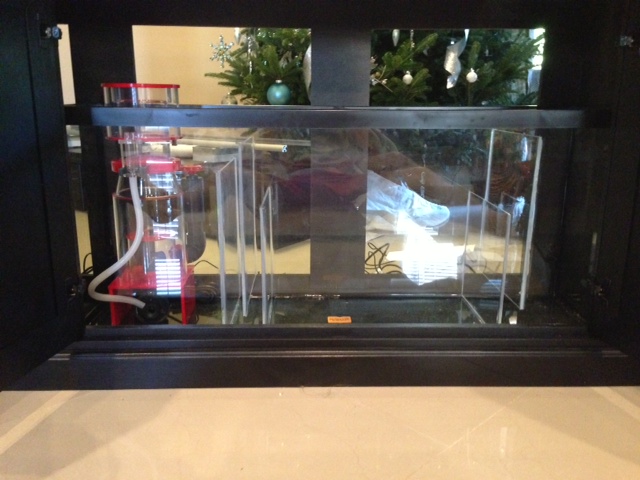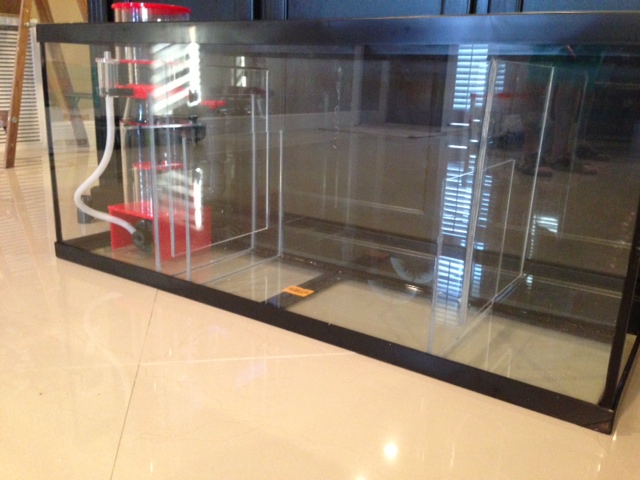For a 150g, you should have ample room for a 55g sump. Building it yourself is a matter of getting some glass baffles cut and smearing on some silicone - it's not a really bid deal. You can typically pick up a used 55g tank for about $25-50 dollars if you look on C-list. I would stay away from a wet/dry filter - because they do require so much maintenance. I don't know about you, but pulling out 300 little blue balls and washing them every month or two is a pain in the butt!!! I'd much rather have some basic mechanical filter such as some quilters batting (what I use and it's cheap!!) or even a filter sock clip on for your DIY sump. Mechanical filtration is important to keep a clean sump, but not necessary with a refugium and a fully maintained sandbed.
Personally, if I had a 55g tank to set a sump up in, I'd put my mechanical filtration and protein skimmer in the first chamber of the sump - and then I would have a really long "run time" through a refugium with macroalgae and then have the last section as a return pump chamber. I'd also make room in the stand for an Auto Top Off system. Because a 150g with a sump will definitely create a lot of evaporation. You will want an ATO so that you will only have to fill the reservoir every five to seven days instead of the sump every single day - perhaps twice a day.
I have no idea why you went with an Eshopps protein skimmer.. While they do have good cheap overflow boxes, their protein skimmers really lack in any actual skimming capacity. It's like buying a 1988 oldsmobile when you can afford a 2012 chevy impala. But, you will discover this with time. For the money, I highly recommend the Reef Octopus brand skimmers. I have a diablo 160 - which is rated for a 160g aquarium, and it works like a charm.

They are solid built and the pumps that come with them are the most important (and most expensive) thing. Italian made Sicce PSK600 pumps are typical octopus cone skimmers these days.
Since you are planning on having a reef tank - you will also want powerheads for water circulation. Water flow isn't just as simple as putting a powerhead or two in your tank and letting it move the water around - they have to be goal oriented. The purposes of water flow is to carry nutrients and waste to and from your corals, provide o2 and co2 where necessary and to remove detritus from rocks and into your mechanical filtration. I don't have one, but I highly recommend getting a Vortech MP40 OR you could look into some variable flow Tunze powerheads. As long as you stay within a 20x to 30x internal turnover rate in your tank you should be fine with any coral that you want. There will be some places that have high flow and some places that have low flow - and you will need to know approximately what locations certain corals do best in.
You will also need a set of materials to do tank maintenance...
credit card scraper - or one of those things with the long handle you can buy at the store.
turkey baster
powerhead for mixing saltwater
salt - like instant ocean or reef crystals
1 cup and 1/2 cup measuring cups
RO/DI Unit with TDS meter and extra filters
Mixing container - such as a food grade plastic container or seperate aquarium
vinyl tubing for water changes (I like to use a powerhead to not only mix the salt, but also to pump the new saltwater into the display tank.)
timers or a controller to monitor and control all of your lights.
digital temperature probe
Two medium sized heaters about 200w each - I like Jager heaters - which have proven to me over the years to be effective and high quality.
refugium in your sump with macroalgae like Chaetomorpha or a breed of caulerpa that is legal in your state.
Refugium lighting - such as a high powered CFL bulb that puts out a minimum of 1600 lumens. One per square foot.
You may want to install a GFCI Unit on your power outlet - so that you can avoid getting shocked or electrocuting your fish.



